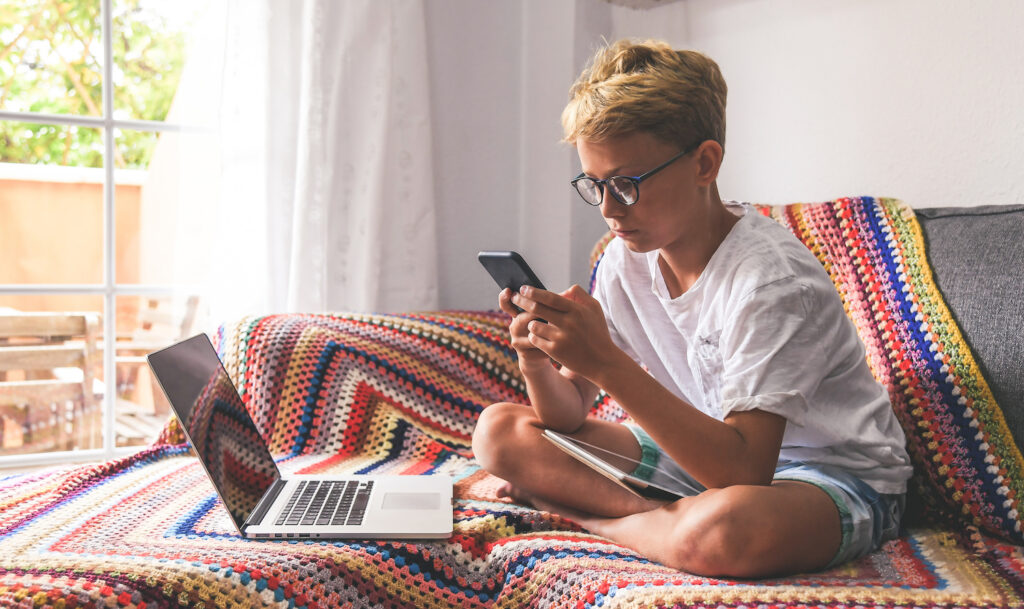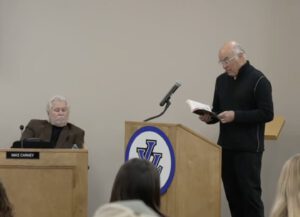Children exposed to porn, strangers via school tablets, apps: ‘Nothing to screen these people’
A mom in the Kansas City area thought her daughter’s fascination with “Furries” – sometimes described as a subculture of people interested in animals with human characteristics – reflected…

A mom in the Kansas City area thought her daughter’s fascination with “Furries” – sometimes described as a subculture of people interested in animals with human characteristics – reflected her artistic personality.
“They have these masks that they wear, and you have to wear gloves, and you affix a tail to the back of you,” she said, requesting anonymity to protect her child’s identity. “I’m like, ‘Oh great, this is an artistic thing.’ Because she’s really artsy.”
That changed when she was carrying laundry past her daughter’s bedroom and heard a man’s voice from inside: “Show me your tail, girl.”
She looked into the bedroom to see her daughter, then 11 years old, with two girlfriends watching a YouTube live-stream. Upon further research, the mom discovered other children their age were making these videos on their own YouTube channels, which can be set up using email addresses supplied by the Shawnee Mission School District for Google Classroom accounts.
“It’s one thing if you do that in your own home – that’s on you. That’s your child, and that’s up to you,” she said. “But when a school enables it, you don’t have any control. They give your child a tablet, they give him the email address, they give him the VPN where they can access. They’ve got the Wi-Fi. What do you think you’re controlling at that point?”
‘All of it’s driven by data’
As public schools increasingly rely on educational technologies such as tablets, apps, and social media to run classrooms, parents like this mom find themselves battling a system that bypasses all their household’s online restrictions or filters.
“When they have their tablet or Chromebook and they’re logged in to the school, through the school’s Wi-Fi, the school’s VPN overrides your parental controls on your network at home,” she said.
Several other parents contacted by The Lion requested anonymity upon sharing their experiences with KC-area school districts:
- A mom whose child was in the Olathe school district found inappropriate content coming through ads from a free teacher’s website, which was being used for an English assignment.
- Another mom asked her son’s elementary school to remove his device after she found he was using it to search for sex-related keywords. The school refused to honor her request.
Students access online pornography frequently on school-owned devices, according to SlateXP, a company who makes LearnSafe to monitor at-risk digital behavior in schools.
“By the age of 17, 75% of teenagers have seen explicit images on the internet,” the company writes on its website. “Most first encountered online pornography at the age of twelve. These encounters were often accidental.”
Even with all the known risks, parents expressed frustration at the schools’ lack of response to their concerns.
“All of it’s driven by data,” said the mom who found her daughter watching the YouTube live-stream. “The ed tech companies, they want the data. And the only way they get that data is if every child has a number, and every child has a Chromebook.”
‘As a parent, you have no idea’
Even before the Furries incident, this mom had already experienced problems with the Shawnee Mission School District over her son’s school-issued tablet.
“My youngest was 6 when we moved here,” she said, adding excessive screentime caused him to lose impulse control. “I requested that his tablet be kept at school. He didn’t have homework, there was no reason for him to bring it home, we didn’t want to have that fight. … I really had to fight for that.”
Two years later during the COVID-19 pandemic, the school reversed course and required her to keep her son’s tablet at home. Several of her son’s friends then taught him to put an alternative search engine on his tablet without his parents knowing, the mom said.
“When you open Clipart and you search something – he had searched ‘naked married love’ – the Clipart comes up, and that gives you thousands of pictures,” she said. “So then if you click – because they use Clipart at school – if you click on one of those, that’s going to open thousands more pictures. He had 15 tabs open at that point.”
The mom kept records of some of the pornographic images she had found her then 8-year-old son viewing in his bedroom.
“Once you know it, you can’t un-know it,” she said. “And as a parent, you have no idea what your kid is dealing with.”
She approached the school, but nothing changed.
“I was told that he signed the Responsible Technology Agreement, which is basically, to my thinking, the same as saying, ‘This is on him,’” she said.
The school district did not respond to The Lion’s request for comment by publication time.
‘Seeds of a mental health crisis’
Despite increasing evidence into the connection between excessive screen time affecting children’s mental health, public schools aren’t willing to change their policies, this mom said.
“Everything tells us that kids on screens is bad for their mental health,” she said. “And for some reason, at the schools, they kind of want to bypass that. Then out of the other side of their mouth, they’re screaming about a mental health crisis.”
In fact, mental health resources suggested by schools can even contribute to the problem, this mom argues.
She pointed to the Indian Hills Middle School’s “Peace Corner” page under Student Services on its website. It lists The Trevor Project among websites on its “Need Help Now?” page.
The Trevor Project describes itself as an organization with a mission “to end suicide among LGBTQ young people.”
“If you go here, you can reach a counselor and be texting with them in a matter of about 30 seconds,” the mom said. “And two of the things that they want to know on the intake is your sexuality and your gender expression. These are 12- and 13-year-old kids. You have to put that in before you can reach a counselor.”
The mom also showed The Lion her online account on “Trevor Spaces,” described as “an affirming, online community for LGBTQ young people between the ages of 13-24.”
“When you first go into the app, it reminds you that you can push this button to immediately exit from this program, and it will clear your browser history so Mom and Dad will not know that you’ve been doing this,” she said.
Users can access a “Secret Message Box” to send anonymous photos to one another, along with fields like gender pronouns, gender identity, and religious orientation.
“There’s so much pressure on these kids to profess their sexuality, and their gender,” she said. “You’ve got a girl who hasn’t even started her period yet, and she’s being asked what her sexual preferences are, and to state them.”
The mom shared numerous forums on “Trevor Spaces” to The Lion, including ones that promoted the ability to find people local to the child user’s geographical area.
“There’s nothing to screen these people,” she said of other users, many of whom were praising the photos of children dressed up in double horns, dog collars, and other sexually suggestive clothing. “There’s no monitoring.”
Importantly, the schools are facilitating children’s access to these services, she said.
“Kids are able to get to this through their school tablet, and you will never know it,” she said. “It erases the browser history. They have a password, it’s password-protected. They’re able to access this from your Chromebook, and the link is provided by the school. And no one is doing anything about it.”
This mom also interviewed one of the counselors at the Trevor Project, pretending to be a 13-year-old boy.
“In the span of about seven minutes, he asked me if I was suicidal three times,” she said. “I said no every time.”
The mom found this problematic, especially since the behavior didn’t seem right for a counselor.
“For like every year up until – I don’t know – COVID, we knew that you don’t introduce the idea of suicidality to young people,” she said. “You don’t talk about it, you avoid the word, you say things like ‘harming yourself’ if you have to, but you don’t start asking kids all the time if they feel like they’re suicidal because you introduce the idea that you could possibly be suicidal.”
This mom also found the so-called counselor willing to bypass parental notification through text messages when she said – still pretending to be a 13-year-old boy – the online conversation would have to end once the child’s parents came home.
“They have no idea what they’ve opened up and what those kids are being exposed to,” she said of the schools. “And if you want to discuss the seeds of a mental health crisis for 12- and 13-year-olds, these kids have seen a lot.”
Library apps, social media
In addition to questionable resources such as the Trevor Project, this mom also took issue with school-approved apps, especially those connecting to public libraries.
“It puts everything on the public library available on your tablet, so you can pretty much find anything that you would find in the public library,” she said.
Once she searched for one book she had heard about on her daughter’s school tablet, the app began making other recommendations using its algorithm.
“In a lot of this young adult fiction, some of these authors are making really easy money writing books about polyamorous relationships or love triangles involving same-sex relationships,” she said. “Now the algorithm reads that you’re interested in polyamorous relationships and homosexuality. So it begins suggesting other young adult fiction that you might like.”
She also recounted the pressure for children to start using social media for school assignments.
“You’re telling kids, ‘Social media is bad for you, but in our classroom group for this project we’re working on, we’re only communicating through Snapchat,’” she said. “So we kind of had to get our daughter a device because that’s where the communication was happening with the school.”
This mom decided to withdraw her children from the school in December 2021 when she discovered a school official, doing her practicum in social work, had been seeing her daughter without parental knowledge or consent.
“I think she was 23-years-old,” she said. “She had been pulling our daughter out of class and meeting her without notifying us. So that’s when we pulled them.”
Her daughter is now doing much better at an area private school that limits student access to technology and allows school devices to align with parental controls at home, she said.
“At public school, you have no recourse,” she said. “You’re standing up against an institution that really wants you to shut up. They don’t want to answer your questions, they want to put it back on you or talk in circles.”
If even one family can learn from her experiences, sharing her story will have been worth it, she said.
“These are children. Once you open the door to this stuff, you’ve robbed them of something that you cannot get back,” she said. “What I want is for other parents to have this information so they can better protect their kids.”



